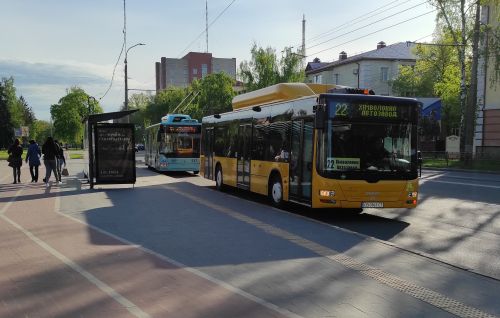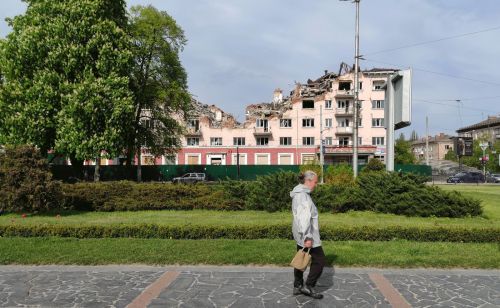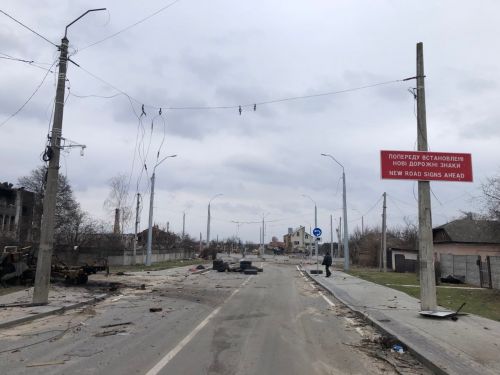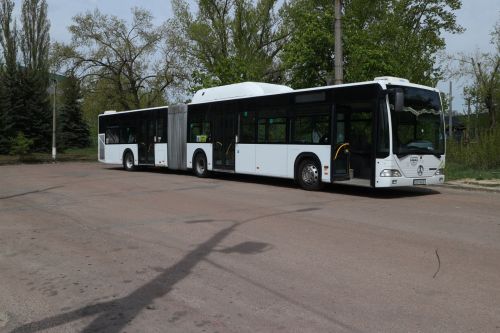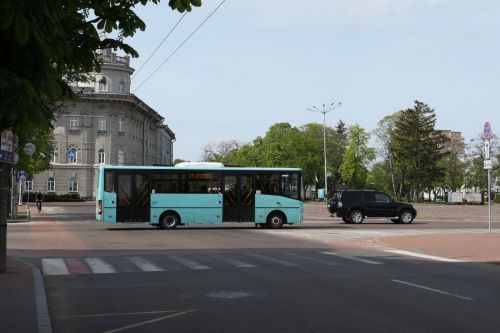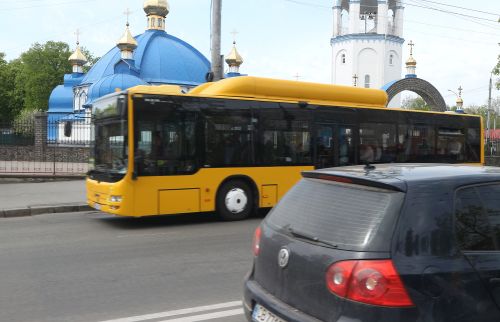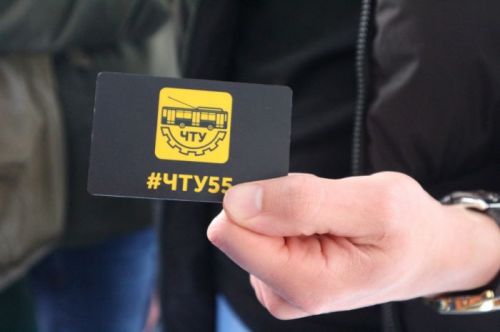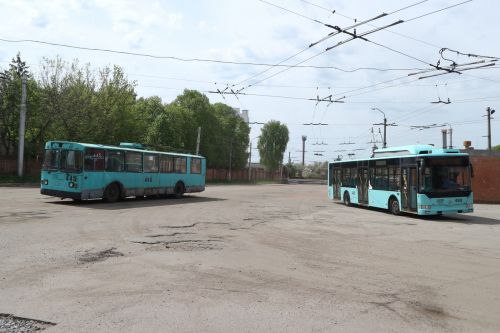Even in the midst of war, Chernihiv is trying to reform its passenger transport sector. The CFTS and representatives of the NGO Vision Zero discuss the current problems and ways to solve them with the managers responsible for the development of public transport in the city.
Shelling and a temporary blockade by Russian troops completely shut down Chernihiv's public transport in the spring of 2022. After that, the city authorities decided to relaunch the sector by introducing several important innovations. How are they changing the city's public transport? What projects can be implemented in the coming years?
"You have chosen a good time to visit Chernihiv," says Oleksandr Ryzhyi, head of the Chernihiv City Council’s Department of Transport, Transport Infrastructure, and Communications. "In May, the city is full of greenery. A sea of tulips in flower beds and flowering trees on boulevards and in squares. You can feel that the city, which had been under siege by enemy troops for more than a month, is returning to peaceful life as far as possible in the current realities.
The OSB boards that are still in the windows of the city administration building are a reminder of last year's shelling. Even in the office of Viktor Heraschenko, Chernihiv’s deputy mayor for executive agencies, where we visited, part of the window is still without glass.
Recovering from shelling
"Chernihiv has suffered greatly from the shelling by enemy troops. We have more than 600 private houses completely destroyed and an additional 2,600 houses damaged. In addition, 872 multi-story buildings were damaged, including 146 with direct hits. The heat and power plant, the city water utility, and Teplokomunenergo were heavily damaged. These are critical infrastructure facilities. It is very difficult to estimate the amount of damage, but it is likely to be in the billions of hryvnia," said the representative of the mayor’s office.
The city's public transport has also suffered. Before the war, there were 10 trolleybus routes in Chernihiv, now there are only 7. "Fifty percent of the overhead catenary network for trolleybuses, which has a total length of 110 km, was destroyed. Shelling also damaged six trolleybuses in the depot. Fortunately, the depot itself survived, although several windows were broken by shell fragments," Ryzhyi said. According to him, 30% of the overhead catenary network has already been restored, with 20% to go. "Work is ongoing on two sections, and we are considering whether to restore another one, as it has low passenger traffic. Buses are currently operating there," said the head of the relevant department.
According to Heraschenko, repairing the damage requires significant funds. "The state provided us with UAH 150 million to help restore the water utility. The same amount was provided by the Red Cross for the construction of housing, restoration of the thermal power plant, and other needs. In particular, the Red Cross provided over UAH 35 million worth of materials for the restoration of the trolleybus overhead catenary network, and Natasha-Agro provided an additional UAH 6 million. In addition, a company based in Slovakia provided 90 poles for the overhead catenary," said the official.
Transport revolution
Restoring the full operation of public transport is one of the priorities of the city authorities. "Last May, the situation was very difficult. Out of the 300 small and medium-sized buses in the city, only 30 medium-sized buses were in working order. After 40 days of heavy bombardment and shelling, public transport was out of operation. We had to launch it virtually from scratch," said Heraschenko. He was the head of the trolleybus department in the mid-2000s, so he speaks about transport with special reverence. "In many ways, the war helped us reform public transport, one of the city's key industries," he added.
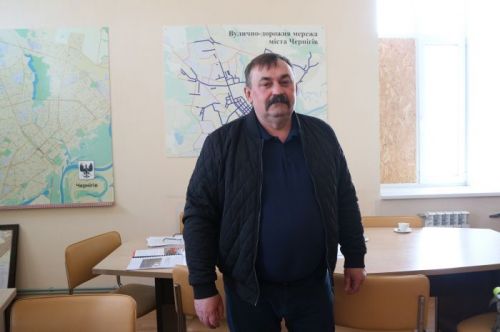
Viktor Heraschenko
The Chernihiv City Council’s Department of Transport, Transport Infrastructure, and Communications has decided to restart public transport in a new way, based on European Union regulation 1370. "After a total shutdown, we started a reboot and took a different path than before. In a sense, it was a revolution," said Ryzhyi. The main essence of the changes is the establishment of additional payments to carriers for transport operations in accordance with agreed schedules and the introduction of a completely new network of public transport routes.
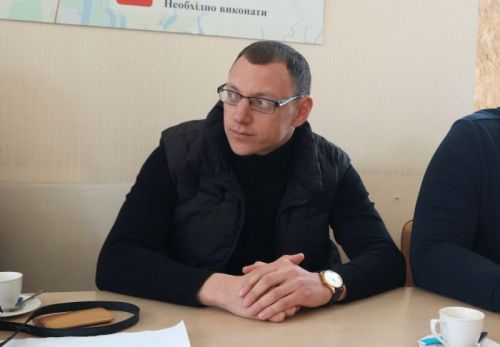
Oleksandr Ryzhyi
To receive the extra payment, the carrier must meet several conditions: complying with the agreed timetables by 94%, ensuring accessibility for people with limited mobility, and the use of electronic tickets. This system has already achieved its first results. "The regularity and fulfillment of schedules have reached almost 98-99%, compared with 65-70% previously. If earlier the carrier was free from control, today we constantly monitor compliance with schedules. Carriers have also started buying new and larger buses with a passenger capacity of over 60 people and a low floor. We are doing everything to ensure that the carrier performs its primary function of transporting passengers," says the head of the transport department.
If one of the conditions is not met, the carrier does not receive any additional payments. Heraschenko provided the statistics for March 2023, according to which only one of the four private carriers operating in the city slightly missed the target (it achieved the schedule target by 91%) while the other three performed well. The established tariff per kilometer for an Ataman diesel bus is UAH 44.12. In total, the city budget provides UAH 40 million for these additional payments.
"So far, this mechanism is being implemented experimentally. I want it to work as a well-established system, regardless of the name of the mayor and the transport department. The city authorities are now working to make this mechanism fully operational," Ryzhyi said.
Another aspect of the transport revolution in Chernihiv is the new route network. Before the war, there were 47 bus routes and 10 trolleybus routes in Chernihiv, but now there are only 13 bus and 7 trolleybus routes covering the entire city.
According to Oleksandr Ryzhyi, this is quite enough. "Previously, there were about 200 small minibuses called Ruta in the city and they went, roughly speaking, from house to house. Now there are a little over 90 buses in the city, but they have a larger capacity and run on a different principle and on different routes. Before the war, there were only nine low-floor buses, now there are over 40," the official adds.
No more chaos
In many Ukrainian cities, there is competition between private and municipal public transport. In Chernihiv, according to city officials, this is not the case. "Public transport should compete with cars, not with each other. This is our position. We do not have any chaos. Today, the city has 52 trolleybuses belonging to the municipal trolleybus department (we are talking about the daily release of trolleybuses on routes - CFTS) and 93 buses owned by four private carriers. The city authorities constantly monitor the work of all carriers," explains Oleksandr Ryzhyi. Previously, 13 private carriers were operating in the city, but not all of them were able to meet the new requirements that the city has set as part of the described changes to public transport.
The presence of carriers of various forms of ownership did not prevent Chernihiv from introducing an electronic ticket. You can pay for public transport with cash, a bank card, or a special transport card. The introduction of e-tickets made it possible to launch a transfer ticket.
"We record about 16,000 transfers per month. A passenger can transfer within 30 minutes by paying with a transport card. So far, this works only for trolleybus routes, and we want to fix this so that people can transfer from trolleybus to bus or vice versa," explains the head of the transport department. There are also plans to introduce fare diversification when paying in cash or by card. "We want to narrow down the use of cash for fares as much as possible," he adds.
When asked whether the city authorities are planning to create a single municipal carrier, as some European cities do, Chernihiv officials say no. "We currently have no such plans. The current scheme is quite acceptable for the city. Creating a single municipal carrier is very expensive for the city authorities. In our opinion, public-private partnerships are the best form of public transport organization," says Deputy Mayor Viktor Gerashchenko. According to him, today the city budget pays carriers 15-20% of their transportation costs, which is about UAH 2-3 million per month. "It is more profitable than investing in the purchase of buses and then compensating for the cost of transportation. It is too burdensome for the city budget," he concludes.
Trolleybus projects
After a few hours of conversation at the city hall, we went to the trolleybus depot with Oleksandr Ryzhyi. The chief transport manager of Chernihiv prefers the trolleybus. "I often travel on trolleybuses. Firstly, it's convenient, and secondly, I evaluate the work of public transport as a passenger," he says. Ruslan Yemets, the head of the Chernihiv Trolleybus Department, met us at the depot and continued to inform us about the operations of public transport.
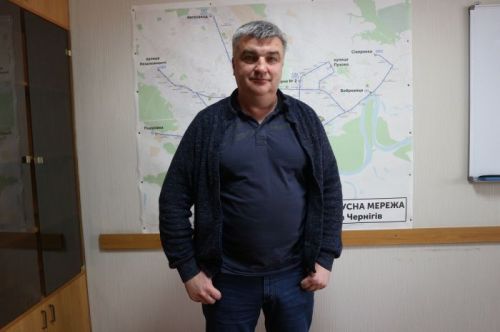
Ruslan Yemets
"Over the past decades, the municipal enterprise has been under pressure from private carriers, just like in other Ukrainian cities. The production of trolleybuses fell by 2.5 times from 2005 to 2015 - from 130 to 50. At the peak, our fleet reached 160 units, and the output was 140 units. It was the 1990s. Before the war, our output was 65 units. Today, our fleet comprises 74 trolleybuses, and the output is 52 units. Once all sections of the damaged overhead line are repaired, we plan to reach pre-war performance levels. This year, we also purchased six more trolleybuses. We are currently registering them and preparing them for regular operation on the lines. We plan to have 80 trolleybuses in operation by June. This is almost enough to meet passenger demand. The city used to have large enterprises with thousands of employees that generated a significant part of the passenger traffic. Now they don't exist," says the head of the Chernihiv Trolleybus Department. According to him, today two-thirds of the fleet are new low-floor trolleybuses, which the city has started purchasing mainly from the Chernihiv Automobile Plant - these are Etalon trolleybuses. In total, 42 new trolleybuses of this company were purchased. The old trolleybuses are being systematically decommissioned by Chernihiv Trolleybus Plant, as their repair is very expensive. For example, a major overhaul of a ZiU trolleybus costs more than UAH 1 million, and a new trolleybus costs about UAH 7 million.
The biggest problem with Chernihiv's trolleybus system is the worn-out infrastructure, in particular, traction substations and especially cable lines. "90% of power cables need to be replaced. The first time we carried out such a replacement was three years ago. Before that, no such work had been performed since the beginning of the trolleybus service in Chernihiv. In general, we plan to replace about 70% of power cables in the coming years. The outdated cable network is the biggest threat to the trolleybus traffic in the city," explains Ruslan Yemets.
Despite this, the manager has several ideas for the further development of the trolleybus network in Chernihiv. Firstly, it is the restoration of the dispatching system. "We have ordered a project for a new system of TV control and dispatching of traction substations, along with the organization of a new control center. This system makes it possible to pinpoint the location of an accident in the cable network without laying additional signal cables. Currently, we have to involve third-party organizations to determine the location of an accident. In a couple of months, we will receive this project and, most importantly, we will know its exact cost," says the head of the Chernihiv Trolleybus Department.
The trolleybus management also plans to introduce dynamic recharging trolleybuses. "In my opinion, this is the most reasonable development for existing trolleybus systems. We assessed where we could install recharging points and free part of the city from the contact network," says Ruslan Yemets. Another project for the future is the purchase of battery trolleybuses with a range of up to 20 km. "Our Chernihiv-based manufacturer Etalon produces trolleybuses of this type, but they are more expensive than conventional ones," he adds.
Unfortunately, the issue of finances remains a key one for the municipal enterprise, as ticket sales account for only 36% of its revenue, with another 3% coming from other types of income. Over 60% are subsidies paid by the city authorities to compensate for privileged transportation. "Despite this, we continue to develop new projects for the further development of the trolleybus network and move towards their implementation. There will always be challenges, but we need to look to the future. The local authorities support us, but the assistance of international donors will also be helpful," Ruslan Yemets concludes.

